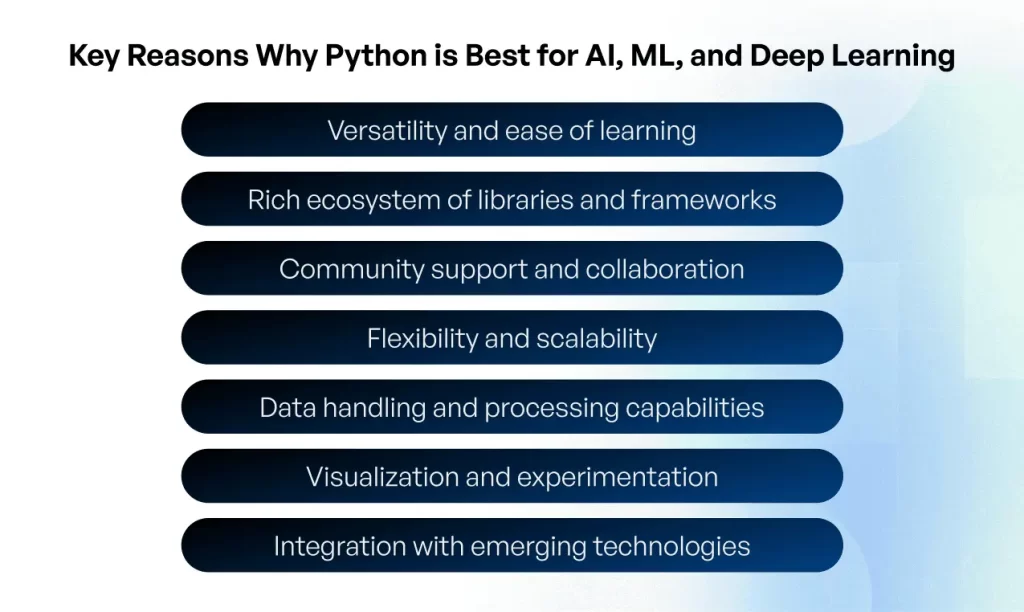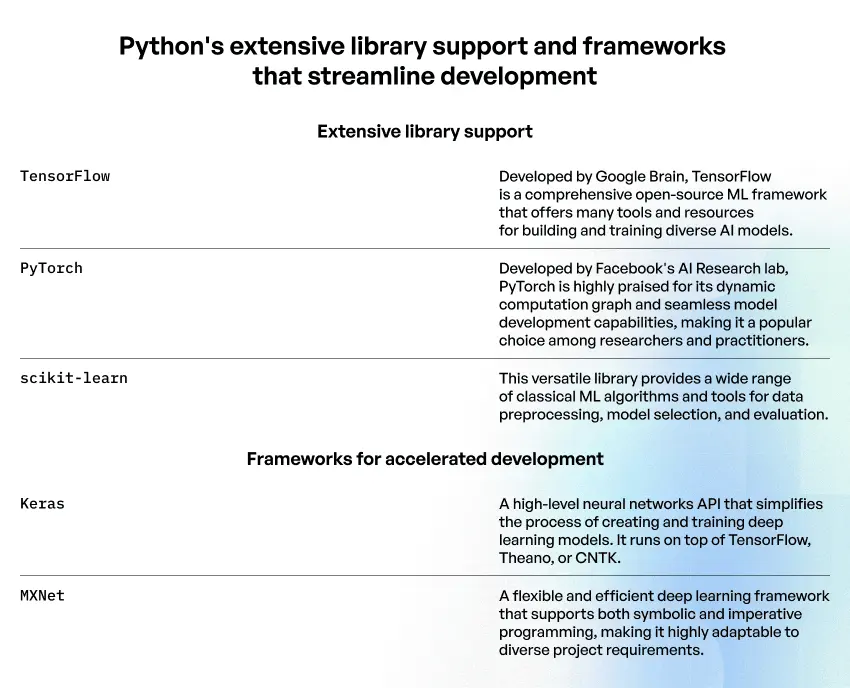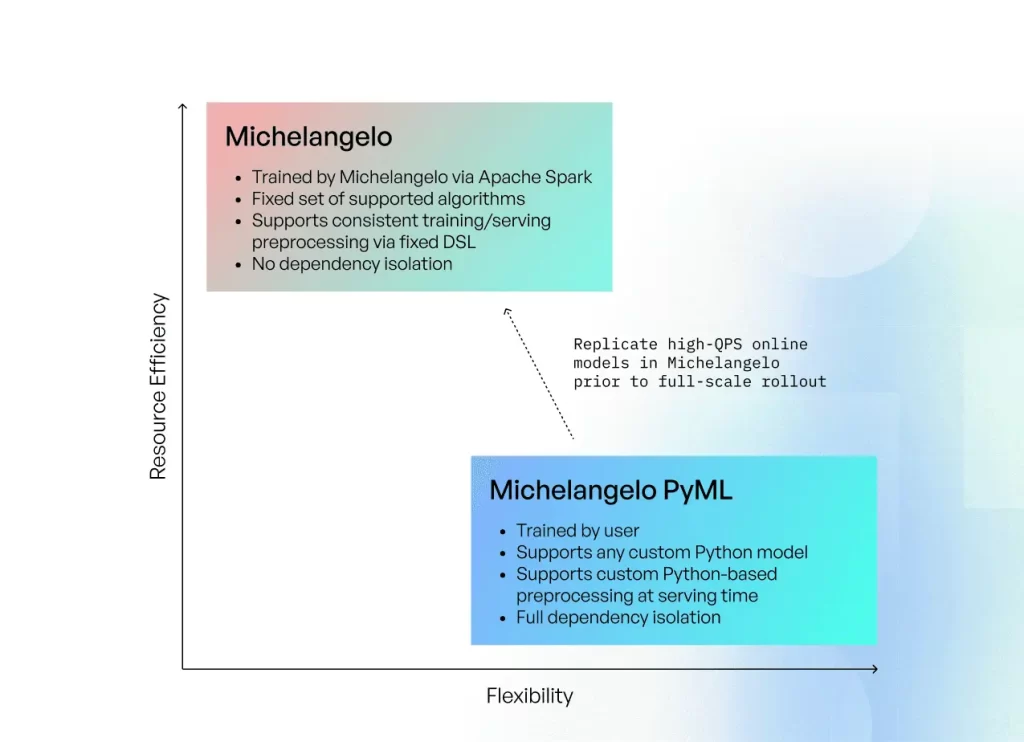The Python Advantage: Unveiling the Top Reasons for its Dominance in AI, ML, and DL

Choosing the right programming language can make all the difference in the dynamic landscape of Artificial Intelligence (AI), Machine Learning (ML), and Deep Learning (DL).
Python has emerged as a standout language, garnering immense popularity and widespread adoption. Its appeal lies not only in its simplicity and versatility but also in the robust ecosystem it offers.
In this article, we shed light on the key advantages that position Python as an indispensable tool in advanced computing. We also consider real-life examples of successful AI, ML, and DL products developed using Python.
Table of contents
- The Rise of Python in AI, ML, and Deep Learning
- The Python Advantage: Key Factors Making it the Premier Choice for AI, ML, and Deep Learning
- Python in Action: Real-World Applications and Case Studies
- Future Trends and Python’s Evolution in AI, ML, and DL
- Summing up
- FAQ
The Rise of Python in AI, ML, and Deep Learning
In recent years, Python has experienced an extraordinary surge in popularity, swiftly establishing itself as the preeminent language for Artificial Intelligence, Machine Learning, and Deep Learning endeavors.
According to a Stack Overflow Developer Survey in 2023, Python is among the most widely used software programming languages worldwide.

This meteoric rise can be attributed to Python’s unparalleled versatility. This characteristic allows it to seamlessly adapt to various AI, ML, and DL applications. Whether it’s data preprocessing, developing intricate algorithms, or creating sophisticated neural networks, Python effortlessly caters to the diverse needs of these domains.
The language’s robust and user-friendly design, coupled with an extensive collection of libraries and frameworks, has propelled its prominence, making it the go-to choice for professionals and enthusiasts.
From powering recommendation systems and predictive analytics to fueling computer vision and natural language processing projects, Python’s role in reshaping the future of technology is nothing short of transformative. Its ascendancy as the lingua franca of AI, ML, and DL is a testament to its prowess and adaptability, showcasing its enduring importance in the rapidly evolving landscape of modern computing.
The Python Advantage: Key Factors Making it the Premier Choice for AI, ML, and Deep Learning
Python has emerged as the quintessential programming language for Artificial Intelligence, Machine Learning, and Deep Learning projects, owing to many vital advantages and attributes. Here, we delve into a detailed exploration of these attributes, shedding light on why Python is the best language for machine learning and AI.

Versatility and ease of learning
Python’s simplicity and readability significantly contribute to its popularity in this domain. Its clear and intuitive syntax makes it accessible for beginners and experienced programmers, enabling quick prototyping and experimentation.
Python’s continuous growth is evident in the PYPL Popularity of Programming Language Index, where Python holds the top position, reinforcing its status as a go-to language for learners and practitioners.
One of the key reasons why Python is good for AI and ML is its expansive ecosystem of libraries such as TensorFlow, PyTorch, Keras, and scikit-learn. These libraries provide pre-built functions and modules, drastically reducing development time and effort. Additionally, they offer a wealth of resources and community support, empowering developers to confidently tackle complex AI, ML, and deep learning tasks. This ease of use and rapid development play a vital role in AI, ML, and DL projects, where experimentation and iteration are fundamental processes.
Furthermore, Python’s ability to integrate seamlessly with other languages and technologies enhances its adaptability and usability within diverse AI and ML workflows. Whether data manipulation, model training, or result visualization, Python provides robust and efficient solutions.
Rich ecosystem of libraries and frameworks
Python boasts an expansive library and framework ecosystem that expedites development and implementation in AI, ML, and DL projects. TensorFlow, PyTorch, scikit-learn, Keras, and NLTK are just a few examples of widely used libraries that provide ready-to-use functions, tools, and pre-built algorithms, significantly reducing development time and effort.

This rich and diverse collection of tools empowers developers and data scientists to tackle various challenges, enabling efficient and streamlined development in the AI landscape.
Community support and collaboration
Python enjoys an enthusiastic and active community of developers, researchers, and practitioners in the AI, ML, and DL domains. This thriving community contributes to many resources, forums, and collaborative platforms. The vast community support ensures timely updates, bug fixes, and a continuous influx of new ideas and innovations.
Python’s vibrant and supportive community plays a pivotal role in its success:
- Active and engaged community. Python boasts one of the largest and most active developer communities worldwide. This vibrant community is passionate, diverse, and committed to advancing AI, ML, and deep learning. Forums, discussion groups, and social media channels dedicated to Python are abuzz with discussions, knowledge sharing, and problem-solving. Prominent platforms like Stack Overflow and Reddit have dedicated sections where community members actively respond to queries and provide guidance related to AI and ML.
- Open-source collaboration. Python’s ethos revolves around open-source development, encouraging collaboration and transparency. Open-source projects related to AI, ML, and deep learning are abundant, allowing contributors to share their expertise, improve existing tools, and develop new solutions collaboratively. Developers can easily access, modify, and extend these projects, fostering an environment of continuous improvement and innovation.
- Knowledge sharing and resources. The Python community offers vast learning resources, including tutorials, blogs, online courses, and documentation tailored to AI, ML, and deep learning. These resources facilitate skill development, knowledge acquisition, and best practice adoption. Individuals entering the AI landscape find abundant guidance and mentorship within the community, accelerating their learning curve.
Read more: How ChatGPT can help your B2B business
Flexibility and scalability
Python’s scalability is paramount for tackling complex AI, ML, and deep learning tasks. With various parallel processing libraries and frameworks, Python can distribute computing tasks efficiently across multiple cores or machines, maximizing performance. Tools like Apache Spark and Dask enable handling vast amounts of data and computations, which is crucial for large-scale AI and ML applications.
Python’s seamless integration capabilities with other languages and platforms enhance its flexibility. Whether interfacing with C/C++, Java, or incorporating web frameworks, Python excels in integrating disparate components. This trait is vital when incorporating AI and ML models into existing software systems or developing hybrid applications leveraging AI capabilities.
Additionally, Python’s adaptability extends to cloud computing environments. Cloud platforms like AWS, Google Cloud, and Microsoft Azure strongly support Python, providing specialized AI and ML services like AWS SageMaker, Google AI Platform, and Azure Machine Learning. Python’s compatibility with these platforms ensures smooth integration and utilization of cloud-based AI services, facilitating scalable and resource-efficient solutions.
Data handling and processing capabilities
Python’s preeminence in artificial intelligence, machine learning, and deep learning is undeniably driven by its unparalleled data handling and processing capabilities. These capabilities empower practitioners to efficiently manipulate, analyze, and derive valuable insights from vast and complex datasets, a cornerstone in AI-related endeavors.
Python’s superior data handling and processing capabilities, bolstered by:
- Rich ecosystem of libraries. Python offers extensive specialized libraries, such as NumPy, Pandas, and SciPy, to facilitate seamless data manipulation and processing. NumPy, in particular, is a fundamental library for numerical operations and multi-dimensional array handling, forming the basis for various AI and ML algorithms.
- Efficient data structures. Python’s versatile and efficient data structures, including lists, dictionaries, sets, and tuples, empower practitioners to organize and manage data easily. These structures are critical in structuring datasets and optimizing algorithms for effective AI, ML, and deep learning model development.
- Streamlined data preprocessing. Data preprocessing is a pivotal step in the AI and ML workflow. With libraries like scikit-learn and TensorFlow, Python simplifies and streamlines data cleaning, normalization, feature scaling, and transformation. This streamlining accelerates the preprocessing phase and ensures high-quality, usable data for model training.
- Interoperability with Big Data tools. Python’s compatibility with big data tools like Apache Hadoop, Apache Spark, and Apache Flink is crucial for handling large-scale datasets. PySpark, for instance, allows seamless integration with Apache Spark, enabling distributed data processing and analysis, a necessity in AI applications dealing with big data.
- Integration with database systems. Python seamlessly integrates with various database systems, including SQL and NoSQL databases. Libraries like SQLAlchemy and PyMongo facilitate connecting to databases, querying, and retrieving data efficiently. This capability is vital when working with diverse data sources in AI and ML projects.
Visualization and experimentation
Python offers a rich toolkit that empowers practitioners to explore, analyze, and present complex data, crucial for understanding model behavior and making informed decisions:
- Robust visualization libraries. Python hosts a variety of powerful visualization libraries, such as Matplotlib, Seaborn, and Plotly that allow for the creation of compelling visualizations. These libraries support diverse chart types, enabling practitioners to represent data in an easily digestible format. Visualization is vital to AI and ML, aiding in model evaluation, feature analysis, and communicating results to stakeholders.
- Interactive plotting and dashboards. Libraries like Plotly and Bokeh provide interactive plotting capabilities, allowing users to interact with visualizations dynamically. This is particularly valuable in AI and ML, as it enables real-time exploration of results, making it easier to identify patterns, outliers, and trends during model evaluation and experimentation.
- Experimentation and prototyping. Python’s expressive and easy-to-understand syntax is ideal for rapid prototyping and experimentation. Data scientists and researchers can quickly implement and test new algorithms, models, and ideas. This agility is essential for iterative development, enabling the refinement of models and strategies based on insights gained during experimentation.
- Integration with Jupyter Notebooks. Jupyter Notebooks, a popular data analysis and experimentation platform, seamlessly integrates with Python. Notebooks facilitate creating and sharing documents that contain live code, equations, visualizations, and narrative text. This integration streamlines the process of documenting experiments, making tracking progress and reproducing results easier.
- 3D visualization for Deep Learning. In deep learning, Python offers libraries like TensorBoard, which provides 3D visualization tools for deep neural network architectures. These visualizations aid in understanding complex neural network structures, facilitating model optimization and debugging.
Integration with emerging technologies
Python integrates with emerging technologies such as the Internet of Things (IoT), cloud, and edge computing. This adaptability allows developers to deploy AI, ML, and DL models across various platforms and environments, enhancing accessibility and usability across multiple domains.
Let’s consider this in more detail!
- Internet of Things integration. Python’s lightweight footprint and efficiency make it an ideal choice for running AI-powered applications on IoT devices, allowing for real-time processing and decision-making at the edge.
- Edge computing and edge AI. Python frameworks like TensorFlow Lite and ONNX (Open Neural Network Exchange) enable deploying AI models on edge devices, optimizing performance and reducing latency.
- Blockchain technology. Python’s integration with blockchain technology is gaining traction, especially for secure and transparent AI and ML applications. Smart contract platforms like Ethereum offer Python-based frameworks like Web3.py, allowing developers to interact with blockchain networks, enabling secure transactions and data sharing in AI and ML projects.
- Natural language processing (NLP) and voice recognition. Python’s vast ecosystem offers specialized libraries like NLTK, SpaCy, and Hugging Face’s Transformers, providing advanced NLP capabilities. Additionally, Python’s integration with speech recognition libraries like SpeechRecognition and pocketsphinx enables the development of speech-based AI applications, driving innovation in voice-controlled technologies.
- Quantum computing. Libraries like Qiskit and PyQuil allow integration with quantum computing frameworks, enabling the development and experimentation of quantum algorithms. Python’s role in quantum computing showcases its adaptability to emerging and evolving technologies.
Python’s versatility, rich library ecosystem, vibrant community, flexibility, data handling capabilities, visualization support, and integration with emerging technologies collectively position it as the best-suited programming language for AI, ML, and DL projects. Its contribution to the advancement of technology is undeniable, and its impact on shaping the future of AI and data-driven decision-making is profound.
Python in Action: Real-World Applications and Case Studies
Python, the dynamic and versatile programming language, has revolutionized the landscape of AI, ML, and DL. Its rich ecosystem of libraries, ease of use, and robust community support have made it the language of choice for implementing cutting-edge projects across diverse industries.
This section explores real-world applications and case studies showcasing Python’s impact in driving innovation and solving complex AI, ML, and DL challenges.
Healthcare
Python is widely adopted in the healthcare industry for applications such as medical imaging analysis, predictive analytics, electronic health record (EHR) management, data analysis, and drug discovery. Its flexibility and robust libraries empower professionals to process medical data efficiently, develop predictive models for patient outcomes, automate administrative tasks, and enhance overall patient care. Python’s role in healthcare is pivotal, enabling data-driven insights, optimized workflows, and advancements in medical research and technologies.
AlphaFold, an AI system developed by DeepMind, a subsidiary of Alphabet, leverages deep learning and protein structure prediction to revolutionize biology and drug discovery. AlphaFold’s predictive accuracy in protein folding has the potential to impact drug development and the understanding of diseases significantly.
One more example is Arterys. Arterys utilizes AI for medical image analysis, enabling clinicians to analyze cardiac MRI images efficiently. The platform provides insights into cardiac functions, aiding in diagnosing and treating cardiovascular diseases.
Finance
According to Accenture’s research, by 2030, AI will add $1.153 billion in value to the financial industry, allowing it to achieve $1 trillion in cost savings.
Python’s versatility and rich ecosystem of libraries enable professionals to develop sophisticated tools and applications to make informed financial decisions, automate trading strategies, and optimize portfolios for better returns. Additionally, Python facilitates efficient data handling and analysis, which is critical for market trend prediction and risk assessment.
For example, PayPal employs machine learning algorithms to detect and prevent fraudulent transactions. The system analyzes transaction patterns, user behavior, and various features to identify potential fraudulent activities, ensuring secure user transactions.
Transportation
Python is utilized in the transportation industry for route optimization, traffic analysis, fleet management, and public transportation planning tasks. Its adaptability and extensive libraries allow professionals to develop efficient algorithms for logistics, real-time traffic monitoring, and passenger information systems. Python plays a crucial role in improving transportation services, optimizing routes, and enhancing overall efficiency and safety in the transportation sector.
For example, Uber created Michelangelo PyML, an ML platform utilizing Python. This platform serves both real-time and batch predictions, addressing everyday operational needs. Extending from the original Michelangelo product, which possessed scalability but lacked flexibility, Michelangelo PyML now allows users to validate models using PyML before replicating them in Michelangelo, ensuring maximum efficiency and scalability.

Source: Uber Blog
Entertainment
Python is a key player in the entertainment industry, used for applications like game development, animation, special effects, content creation, and automation. Its simplicity and extensive libraries empower professionals to create games, generate visual effects, automate repetitive tasks, and develop interactive installations. Python significantly contributes to the creation of captivating and immersive experiences across various entertainment mediums.
For example, Netflix utilizes machine learning algorithms to recommend personalized content to users based on their viewing history and preferences. This enhances user engagement and satisfaction by providing tailored viewing suggestions.
Or, Spotify, a widely-used music streaming platform, utilizes Python for backend services, data analysis, and building machine learning models for personalized recommendations.
These examples underscore Python’s pivotal role in AI, ML, and DL applications across industries. Python’s ease of use, extensive library support, and a vibrant developer community contribute to its widespread adoption and success in creating cutting-edge solutions that address critical challenges in healthcare, finance, entertainment, and beyond. As AI continues to evolve, Python’s position as a primary language for AI-related projects is expected to strengthen, fueling further innovation and breakthroughs.
Future Trends and Python’s Evolution in AI, ML, and DL
AI, ML, and DL continue to advance, and Python remains a pivotal player in shaping the future of these domains. As we gaze into the future, it’s essential to discern the trajectory of Python in AI, ML, and DL, foreseeing the advancements and possibilities:
Efficiency and performance optimization
Python will continue to enhance its performance and efficiency to meet the burgeoning demands of AI, ML, and DL. Efforts will focus on optimizing the language to ensure faster computations and better memory utilization.
Advanced neural network architectures
Python will witness a proliferation of advanced neural network architectures. The language will evolve to support better complex models, such as transformers, attention-based models, and spiking neural networks, to cater to diverse AI applications.
Integration with quantum computing
Python’s integration with quantum computing will deepen, empowering AI practitioners to harness the potential of quantum algorithms. Libraries and tools will emerge to facilitate quantum AI research and applications.
Explainable AI (XAI) and ethical AI
Python will actively contribute to the growing focus on Explainable AI (XAI) and ethical AI practices. The language will evolve to provide tools and frameworks for creating transparent, interpretable AI models while adhering to ethical principles.
Automated machine learning (AutoML)
Python will lead the way in simplifying the AI pipeline through AutoML. The language will offer more advanced automated tools for data preprocessing, model selection, hyperparameter tuning, and result interpretation.
Edge AI and federated learning
With the rise of IoT and edge devices, Python will adapt to support edge AI applications. Additionally, Python will continue to enhance support for federated learning, ensuring privacy-focused model training in a decentralized environment.
Continued evolution of libraries
Python’s rich AI, ML, and DL library ecosystem will keep evolving. Libraries like TensorFlow, PyTorch, scikit-learn, and spaCy will witness advancements in performance, ease of use, and integration, further fueling innovation.
Natural language processing (NLP) advancements
Python will witness remarkable strides in NLP, with more sophisticated algorithms for language understanding, sentiment analysis, and generation. Transformer-based models and contextual embeddings will be central to this evolution.
Python’s future in AI, ML, and DL is bright and dynamic. It will adapt to embrace emerging technologies, facilitate advanced research and development, and empower a new era of intelligent applications.
Summing up
Python’s reign as the preferred programming language for Artificial Intelligence, Machine Learning, and Deep Learning is deeply rooted in its unparalleled versatility and robust ecosystem.
From its simple and intuitive syntax, making it accessible to both beginners and experienced developers, to its vast collection of libraries and frameworks empowering rapid development, Python truly excels. Its vibrant community, flexibility, scalability, and exceptional data-handling capabilities further solidify its position as a go-to language for AI, ML, and DL projects.
Python remains the beacon of innovation, empowering developers and data scientists to push boundaries and pioneer the next generation of intelligent solutions. Its journey has just begun, and as the future unfolds, Python’s influence will undoubtedly continue to shape the ever-evolving landscape of AI, ML, and DL.
If you need more proficiency in utilizing Python for your business needs, seek expert guidance. Feel free to contact Alternative Spaces. We can provide a consultation and offer software engineers to hire or build a solution for your business from A to Z.
FAQ
- Is Python suitable for real-time applications like autonomous vehicles?
Yes, Python is used in real-time applications like autonomous vehicles thanks to its compatibility with frameworks supporting real-time processing, such as TensorFlow and OpenCV. With proper optimizations and hardware integration, Python can handle the demands of real-time AI processing.
- What are the future trends for Python in AI, ML, and DL?
Python’s future in AI, ML, and DL is promising, with trends like Explainable AI (XAI), Federated Learning, Edge AI, and Quantum Computing gaining traction. Python is continuously evolving to integrate with emerging technologies, optimize performance, and enhance its libraries to cater to these trends and shape the future of AI and ML.
- Which Python libraries are essential for AI, ML, and DL projects?
Some essential Python libraries for AI, ML, and DL include:
- TensorFlow: For building and training deep learning models.
- PyTorch: A popular deep learning framework for building neural networks.
- scikit-learn: A versatile library for classical machine learning algorithms.
- Keras: A high-level neural networks API, often used with TensorFlow.
- Can Python handle data preprocessing and analysis for AI and ML projects?
Yes, Python is exceptionally well-suited for data preprocessing and analysis in AI and ML projects. Python offers a rich set of libraries, such as Pandas, NumPy, and SciPy, which provide powerful data manipulation, cleaning, transformation, and statistical analysis tools. These libraries enable data scientists and analysts to prepare efficiently and structure data before feeding it into AI and ML models, a crucial step in the data-driven decision-making process.
Content created by our partner, Onix-systems.
Source: https://onix-systems.com/blog/python-is-best-for-ai-ml-and-deep-learning Home
Home



